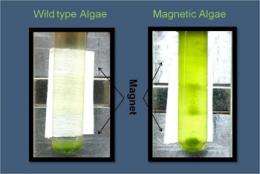LANL develops first genetically engineered 'magnetic' algae

LANL scientists have genetically engineered "magnetic" algae to investigate alternative, more efficient harvesting and lipid extraction methods for biofuels. The researchers seek to reduce the cost of algae-based biofuel production.
Currently, used algae-harvesting and lipid-extraction technology accounts for almost 30 percent of the total cost of algae-based biofuel production.
By inducing paramagnetic properties in algae, a permanent magnet-based separation could provide a low-cost alternative to current technologies.
How?
The project, led by Pulak Nath of the Lab's Applied Modern Â鶹ÒùÔºics group and Scott Twary of LANL's Biosecurity and Public Health group took a gene that is known to form magnetic nanoparticles in magnetotactic bacteria and expressed it in green algae.
Magnetotactic bacteria are anaerobic microorganisms that follow the earth’s magnetic field to avoid exposure to oxygen.
A permanent magnet can be used to separate the transformed algae from a solution.
The scientists think that the magnetic nanoparticles formed within the algae cause the cells to respond to magnetic fields.
These biogenic magnetic nanoparticles could also be harvested separately and used as a valuable coproduct for biomedical imaging and cancer treatments.
Other LANL team members include student Maria Avrutsky and postdoctoral researcher Chaitanya Chandrana.
Provided by Los Alamos National Laboratory

















